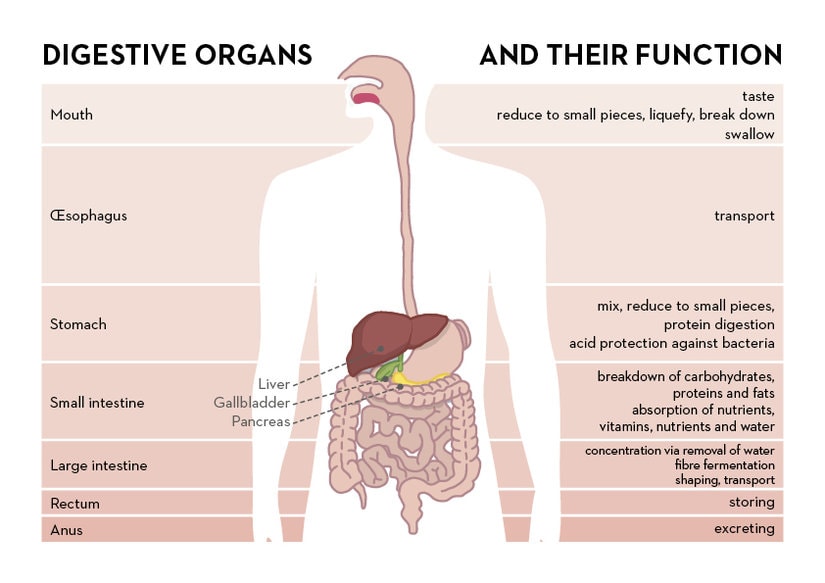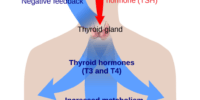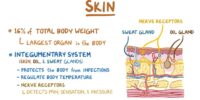What Is The Digestive System? Process And Function Of Digestion

The digestive system is a complex and intricate network of organs and processes that work together to break down food and absorb nutrients. It plays a vital role in maintaining our overall health and well-being. Understanding the process and function of digestion can help us make informed choices about our diet and lifestyle, as well as help us identify and prevent common digestive problems.
The digestive system begins in the mouth, where food is broken down into smaller pieces by the teeth and mixed with saliva. From there, it travels down the esophagus and into the stomach, where it is further broken down by acid and enzymes. The nutrients are then absorbed into the bloodstream through the small intestine and any remaining waste is eliminated through the large intestine. Along the way, the liver and pancreas produce enzymes and bile to aid in digestion.
This article will provide an overview of each stage of the digestive process and common digestive problems, as well as tips for maintaining a healthy digestive system.
Key Takeaways
- The digestive system breaks down food and absorbs nutrients, playing a crucial role in maintaining overall health and well-being.
- The process of digestion begins in the mouth and involves the stomach, small intestine, and large intestine, as well as the liver and pancreas.
- Common digestive issues such as constipation and GERD can be prevented by maintaining a healthy diet, staying hydrated, and exercising regularly.
- The liver and pancreas play a crucial role in digestion and nutrient absorption, and without them, the body would not be able to properly break down and absorb nutrients.
The Mouth: Where Digestion Begins
The initial stage of the digestive process occurs in the oral cavity, where the mechanical and enzymatic breakdown of food begins.
The mouth is responsible for breaking down food into smaller pieces through the process of chewing, which involves the use of teeth and tongue. The teeth are responsible for physically breaking down food into smaller pieces, while the tongue helps to mix food with saliva to form a bolus that can be easily swallowed.
Salivary enzymes present in the mouth, such as amylase, lipase, and protease, begin the process of chemical digestion by breaking down carbohydrates, fats, and proteins respectively. The enzymatic breakdown of food in the mouth helps to prepare the food for further digestion in the stomach and small intestine.
Once food is broken down in the mouth, it is swallowed and transported to the stomach through the esophagus, where further digestion occurs through the action of stomach acid and digestive enzymes.
The Esophagus: Transporting Food to the Stomach
Food travels from the mouth to the stomach through a muscular tube lined with mucous membranes called the esophagus. The esophagus is about 25 centimeters long and extends from the pharynx to the stomach.
It is divided into three parts: the upper, middle, and lower esophagus. The upper esophagus is composed of skeletal muscle, while the middle and lower esophagus are made up of smooth muscle. These muscles work together in a coordinated manner to propel food down the esophagus and into the stomach through a series of contractions known as peristalsis.
The esophagus also has two sphincters that control the flow of food: the upper esophageal sphincter (UES) and the lower esophageal sphincter (LES). The UES opens to allow food to enter the esophagus from the pharynx, while the LES opens to allow food to enter the stomach.
The LES also prevents stomach acid and contents from flowing back up into the esophagus, which can cause heartburn and other discomforts. Overall, the esophagus serves as a crucial transport system for food, ensuring that it reaches the stomach safely and efficiently.
The Stomach: Breaking Down Food with Acid and Enzymes
Acid and enzymes work together in the stomach to break down ingested substances. The stomach is a muscular sac that receives food from the esophagus.
The stomach’s inner lining contains millions of tiny gastric glands that secrete hydrochloric acid (HCl) and enzymes such as pepsin. HCl creates an acidic environment in the stomach, which is necessary for the activation of pepsin. Pepsin is a digestive enzyme that breaks down proteins into smaller peptides.
When food enters the stomach, it is mixed with gastric juices by muscular contractions. This process turns the food into a liquid mixture called chyme, which can be easily absorbed by the small intestine.
To further understand the process of digestion in the stomach, here are some key points to keep in mind:
- The stomach can hold up to 3 liters of food, but it typically only holds about 1 liter.
- Food stays in the stomach for about 2-4 hours before it is released into the small intestine.
- The stomach releases chyme into the small intestine in small amounts to allow for proper digestion and absorption.
- The stomach also plays a role in the regulation of hunger and fullness through the release of hormones such as ghrelin and leptin.
- Some medical conditions can affect the function of the stomach, such as ulcers and acid reflux disease.
The Small Intestine: Absorbing Nutrients into the Bloodstream
Millions of tiny finger-like projections called villi line the walls of the small intestine, increasing the surface area available for nutrient absorption into the bloodstream.
The small intestine is the longest portion of the digestive system, measuring roughly 20 feet in length. This organ is responsible for breaking down food particles even further, using enzymes released by the pancreas and bile from the liver to complete the chemical digestion process.
As food particles move through the small intestine, nutrients such as carbohydrates, proteins, and fats are absorbed into the bloodstream through the walls of the villi.
The villi contain specialized cells called enterocytes, which are responsible for absorbing and transporting nutrients into the bloodstream. These nutrients are then transported to the liver, where they are processed and distributed to the rest of the body.
The small intestine plays a crucial role in the digestive process, ensuring that the body receives the nutrients it needs to function properly.
The Large Intestine: Absorbing Water and Eliminating Waste
The large intestine, also known as the colon, plays a crucial role in maintaining water balance in the body and eliminating waste products through feces.
As digested food passes through the small intestine, most of the nutrients and water are absorbed into the bloodstream. The remaining undigested food, waste products, and water move into the large intestine where they are stored until elimination.
The large intestine is responsible for absorbing any remaining water and electrolytes from the waste material. As the waste products move through the colon, the colon walls absorb water, which makes the waste material more compact and solid. The colon also absorbs electrolytes, such as sodium and potassium, from the waste material.
This process of absorbing water and electrolytes helps to maintain the body’s balance of fluids and electrolytes. Finally, the waste material that is left over is eliminated from the body through the rectum and anus in the form of feces.
The Liver and Pancreas: Producing Enzymes and Bile
The liver and pancreas play a significant role in the maintenance of digestive health, producing enzymes and bile that aid in the breakdown and absorption of nutrients in the body. The liver produces bile, a greenish-yellow fluid that helps in the digestion of fats. It is stored in the gallbladder and released into the small intestine when needed. Bile emulsifies fats, breaking them down into tiny droplets that can be more easily digested by enzymes. This process increases the surface area of the fats, making it easier for lipase, an enzyme produced by the pancreas, to break them down into smaller molecules that can be absorbed by the body.
The pancreas also plays a crucial role in digestion by producing enzymes that break down carbohydrates, proteins, and fats. These enzymes are released into the small intestine to aid in the process of digestion. The pancreas produces three main enzymes: amylase, which breaks down carbohydrates; protease, which breaks down proteins; and lipase, which breaks down fats. Without these enzymes, the body would not be able to absorb nutrients properly, leading to malnourishment. In addition to producing enzymes, the pancreas also secretes insulin and glucagon, which regulate blood sugar levels. The liver and pancreas work together to ensure proper digestion and absorption of nutrients in the body.
| Emotion | Reason |
|---|---|
| Happy | Enzymes produced by the liver and pancreas aid in the breakdown and absorption of nutrients, keeping the body healthy and functioning properly. |
| Grateful | Without the liver and pancreas, the body would not be able to properly absorb nutrients, leading to malnourishment and other health problems. The production of enzymes and bile is essential to our overall health and well-being. |
| Amazed | The liver produces bile, a complex fluid that emulsifies fats, breaking them down into tiny droplets that can be more easily digested by enzymes. The pancreas produces three different enzymes that help in the digestion of carbohydrates, proteins, and fats. |
| Curious | How do changes in diet affect the production of enzymes and bile in the liver and pancreas, and how does this impact overall digestive health? What role do genetics play in the production of these digestive enzymes and bile? |
| Informed | The liver and pancreas work together to ensure proper digestion and absorption of nutrients in the body. Without these organs, the body would not be able to properly break down and absorb nutrients, leading to malnourishment and other health problems. |
Common Digestive Problems and How to Prevent Them
Preventative measures are essential in maintaining optimal gastrointestinal health, especially given the prevalence of common digestive issues. One of the most common digestive problems is constipation, which is characterized by the difficulty or infrequency of passing stools. It can be caused by a variety of factors such as poor diet, lack of physical exercise, dehydration, and certain medications.
To prevent constipation, it is important to eat a diet high in fiber, drink plenty of water, and engage in regular physical activity. Additionally, avoiding certain medications that can cause constipation, such as opioids, and limiting the intake of foods that can contribute to it, such as dairy and high-fat foods, can also help prevent this digestive issue.
Another common digestive problem is gastroesophageal reflux disease (GERD), which occurs when stomach acid flows back into the esophagus and causes irritation. This can lead to symptoms such as heartburn, difficulty swallowing, and nausea.
To prevent GERD, it is important to avoid trigger foods such as spicy and acidic foods, alcohol, and caffeine. Eating smaller, more frequent meals and avoiding lying down immediately after eating can also help prevent this digestive issue. Additionally, maintaining a healthy weight and avoiding smoking can also help prevent GERD.
By following these preventative measures, individuals can reduce their risk of experiencing common digestive issues and maintain optimal gastrointestinal health.
Maintaining a Healthy Digestive System: Tips and Tricks
Optimizing the health of the gastrointestinal tract can lead to a more comfortable and fulfilling life. The digestive system is responsible for breaking down food into nutrients and energy that the body can use. Maintaining a healthy digestive system is important to ensure that the body gets the necessary nutrients to function properly.
Here are some tips and tricks to help maintain a healthy digestive system.
Firstly, it is important to eat a balanced and varied diet. This means including a variety of fruits, vegetables, whole grains, lean proteins, and healthy fats in your diet. Fiber, found in fruits, vegetables, and whole grains, is especially important for maintaining digestive health. It helps to keep the digestive system moving and prevents constipation. Additionally, staying hydrated by drinking plenty of water and limiting alcohol and caffeine intake can also help maintain a healthy digestive system.
Secondly, regular exercise can also help improve digestive health. Exercise helps to stimulate the muscles in the digestive tract, promoting regular bowel movements and reducing the risk of constipation.
Lastly, managing stress levels is important for maintaining digestive health. Stress can affect the digestive system and cause issues such as stomach pain, cramping, and diarrhea. Practicing relaxation techniques such as deep breathing, meditation, or yoga can help manage stress and promote a healthy digestive system.
Maintaining a healthy digestive system is important for overall health and wellbeing. By following these tips and tricks, individuals can promote a healthy digestive system and lead a more comfortable and fulfilling life.
Conclusion
In conclusion, the digestive system is a complex network of organs and processes that work together to break down food and absorb nutrients into the body.
From the mouth to the large intestine, each organ plays a crucial role in this process.
The liver and pancreas produce enzymes and bile that aid in digestion, while the small intestine absorbs nutrients into the bloodstream and the large intestine absorbs water and eliminates waste.
Maintaining a healthy digestive system is essential for overall health and well-being.
Eating a balanced diet rich in fiber, staying hydrated, and avoiding foods that cause digestive problems can help prevent common digestive issues such as constipation, diarrhea, and heartburn.
It is also important to listen to your body and seek medical attention if you experience persistent digestive symptoms.
By taking care of your digestive system, you can ensure that your body is able to efficiently process the nutrients it needs to function properly.








